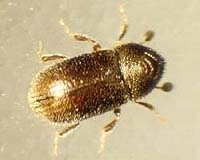| . |  |
. |
Albany CA (SPX) Dec 29, 2010 Synthesizing more than 10 years of cooperative research on the exotic invasive, quarantine sudden oak death pathogen, the USDA Forest Service's Pacific Southwest Research Station (PSW) recently published "Sudden Oak Death and Phytophthora ramorum: A Summary of the Literature." This 181-page comprehensive report covers a wide range of topics, including a history of sudden oak death, identification and distribution of the disease, epidemiology and modeling, management and control, and economic and environmental impacts. Compiled by retired U.S. Forest Service Pacific Southwest regional forest pathologist John T. Kliejunas, the report summarizes research findings published by hundreds of scientists from U.S. and international government agencies and universities, many supported by PSW's extramural Sudden Oak Death research program. "The sudden oak death pathogen is a concern to society since it damages cherished and economically valuab le trees, forest ecosystems, ornamental nursery plants and is an emerging, exotic microbe," said Susan Frankel, PSW's sudden oak death research manager. "This book distills a decade of discovery, exploration and struggle to contain and understand the pathogen's behavior and impact in wildlands, gardens, and nurseries worldwide. Regulators, forest pathologists, and the nursery industry are utilizing this information to work together to prevent both pathogen spread and future exotic pest introductions." The pathogen was new to science when identified in 2000. Information about the disease is scattered in scientific journals, government reports and newspaper articles, so this volume provides a cohesive narrative of what is known about the sudden oak death pathogen for a professional audience, college students and others interested in the biology and management of this pathogen. Key results include: advances in genetics and diagnostics that show the pathogen has inadvertently been shipped long distances on nursery stock and can escape infested nurseries and infect adjacent forest vegetation; pesticide and other treatments for high-value trees and nursery stock; waterway early-detection monitoring techniques; and the discovery of several new related Phytophthora species. Sudden oak death first appeared in the mid-1990s when an unusual die-off of coast live oaks and tanoaks was observed in Marin County, Calif. In coastal California, the pathogen has killed over a million trees, many in densely populated neighborhoods. The pathogen threatens the health of U.S. oak forests in the Midwest and East. Quarantined in the U.S., European Union, Canada and more than 60 other countries, it has been detected on rhododendron, camellia and other ornamental nursery plants in North America and Europe; nursery detections trigger mandatory eradication. Recent outbreaks in the United Kingdom on Japanese larch are requiring the clear-cutting of thousands of trees. The risk to U.S. larch and other conifer species is not yet known. Additionally, recent detections in rivers in the Pacific Northwest and Southern U.S. are a threat that could lead to pathogen establishment in new areas. Information on how to download or order a free copy of the report, "Sudden Oak Death and Phytophthora ramorum: A Summary of the Literature" can be found at: http://www.fs.fed.us/psw/publications/documents/psw_gtr234/.
Share This Article With Planet Earth
Related Links Pacific Southwest Research Forestry News - Global and Local News, Science and Application
 Beetle-ridden forests lose climate help
Beetle-ridden forests lose climate helpMoscow, Idaho (UPI) Dec 17, 2010 Forests infested by bark beetles struggle to fulfill their role as climate modulators, even decades after recovery from the infestation, U.S. researchers say. Scientists at the University of Idaho say northern pine forests are under siege from the insects, with some infested stands at risk of losing at least 50 percent to 80 percent of mature trees, ScienceNews.org reported Friday. ... read more |
|
| The content herein, unless otherwise known to be public domain, are Copyright 1995-2010 - SpaceDaily. AFP and UPI Wire Stories are copyright Agence France-Presse and United Press International. ESA Portal Reports are copyright European Space Agency. All NASA sourced material is public domain. Additional copyrights may apply in whole or part to other bona fide parties. Advertising does not imply endorsement,agreement or approval of any opinions, statements or information provided by SpaceDaily on any Web page published or hosted by SpaceDaily. Privacy Statement |